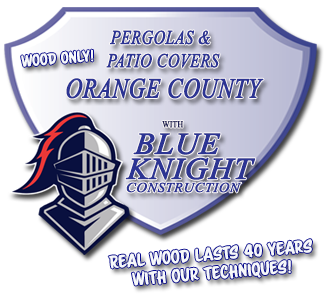
Wood Patio Covers & Pergolas Huntington Beach
To Skip Intro Page,
Click Here

Thank You For Checking With Us!
Huntington Beach residents, we know that you have many choices of Wood Patio Cover Contractors and we appreciate your consideration. It is our privilege to serve this beautiful and gracious community.
Let's Get Right to the Reason for your Google Search Today:
Simply put, the real reason why your existing wood Patio Cover now has dry rot and/or termites, is because of poor weather proofing techniques used during it's original construction.
We on the contrary, use our own techniques and follow higher standards as defined by us. Contractor Joe Ronstadt has a background in engineering and construction innovation. We do not simply paint and nail wood like our competitors. We use our own unique weather proofing techniques that will provide years of trouble-free enjoyment and outlast our competitors by far.
Our services include: Patio Cover & Pergola Repairs and New Construction.
We offer true quality craftsmanship by training our carpenters from the ground up without the baggage of poor industry techniques. We'll prove to you that you made the right decision throughout the job and not just during a sales pitch.
Long story short, our Huntington Beach Patio Covers are constructed with unsurpassed weather proofing techniques. If you want a better result, call Blue Knight Construction.

Courtesy Trivia about Huntington Beach:
"Huntington Beach is a seaside city in Orange County in Southern California. The city is named after American businessman Henry E. Huntington. The population was 189,992 during the 2010 census, making it the most populous beach city in Huntington Beach and the seventh most populous city in the Los Angeles-Long Beach-Anaheim MSA.[citation needed] The United States Census Bureau estimated its 2013 population at 193,480.[7] It is bordered by the Pacific Ocean on the southwest, by Seal Beach on the northwest, by Costa Mesa on the east, by Newport Beach on the southeast, by Westminster on the north, and by Fountain Valley on the northeast.
Huntington Beach (AKA "H.B.") is known for its long 9.5-mile (15.3 km) stretch of sandy beach, mild climate, excellent surfing, and beach culture. The ocean waves are enhanced by a natural effect caused by the edge-diffraction of open ocean swells around the island of Catalina. Swells generated predominantly from the North Pacific in winter and from a combination of Southern Hemisphere storms and hurricanes in the summer focus on Huntington Beach creating consistent surf all year long, thus the nickname "Surf City, USA".
History The Huntington Beach Pier
The area was originally occupied by the Tongva people. European settlement can be traced to a Spanish soldier, Manuel Nieto, who in 1784 received a Spanish land grant of 300,000 acres (1,200 km2), Rancho Los Nietos, as a reward for his military service and to encourage settlement in Alta California. Nieto's western area was reduced in 1790 because of a dispute with the Mission San Gabriel, but he retained thousands of acres stretching from the hills north of Whittier, Fullerton and Brea, south to the Pacific Ocean, and from today's Los Angeles River on the west, to the Santa Ana River on the east.
The main thoroughfare of Huntington Beach, Beach Boulevard, was originally a cattle route for the main industry of the Rancho. Since its time as a parcel of the enormous Spanish land grant, Huntington Beach has undergone many incarnations. One time it was known as Shell Beach, the town of Smeltzer, and then Gospel Swamp for the revival meetings that were held in the marshland where the community college Golden West College can currently be found. Later it became known as Fairview and then Pacific City as it developed into a tourist destination. In order to secure access to the Red Car lines that used to criss-cross Los Angeles and ended in Long Beach, Pacific City ceded enormous power to railroad magnate Henry E. Huntington, and thus became a city whose name has been written into corporate sponsorship, and like much of the history of Southern California, boosterism.
Huntington Beach was incorporated on February 17, 1909 during the tenure of its first mayor, Ed Manning. Its original developer was Huntington Beach Company (formerly the West Coast Land and Water Company), a real-estate development firm owned by Henry Huntington. The Huntington Beach Company is still a major land-owner in the city, and still owns most of the local mineral rights.
An interesting hiccup in the settlement of the district occurred when an encyclopedia company gave away free parcels of land, with the purchase of a whole set for $126, in the Huntington Beach area that it had acquired cheaply.[8] The lucky buyers got more than they had bargained for when oil was discovered in the area, and enormous development of the oil reserves followed. Though many of the old wells are empty and the price of land for housing has pushed many of the rigs off the landscape, oil pumps can still be found to dot the city.
Huntington Beach was primarily agricultural in its early years with crops such as celery and sugar beets. Holly Sugar was a major employer with a large processing plant in the city that was later converted to an oil refinery.
The city's first high school, Huntington Beach High School, located on Main Street, was built in 1906. The school's team, the Oilers, is named after the city's original natural resource.
Meadowlark Airport, a small general aviation airport, existed in Huntington Beach from the 1940s until 1989.
Website orangecountyca.gov
" Courtesy of wikipedia